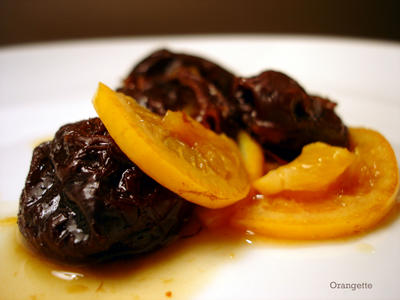The semantics of stewing
In the English language, there are only a handful of phrases that come with their own built-in laugh track, and sadly, “stewed prunes” is one of them. Witness the following exchange, tearfully recorded by yours truly during a phone conversation earlier this week:
Molly: I’m thinking of making stewed prunes.*
Brandon: [Giggle].
Molly: Why are you laughing? Have you ever eaten a stewed prune?
Brandon: [Giggle]. No, but it just sounds funny. I mean, steewwwed pruuune! [Giggle giggle].
It is a dark, dark day, dear reader, when you learn that the man you love—and whose genetic material you would like to help perpetuate, even—is a prune skeptic.
In his defense, Brandon claims that he dislikes all dried fruits, the unfortunate result of being forced to eat too much “hippie trail mix” as a child. Now, it’s bad enough that the delicious prune—or, to use its new, marketing-friendly name, the dried plum—has to work an unglamorous side-job as a laxative, but for it to be discriminated against on the basis of childhood trauma is simply unfair. And anyway, if we really get down to semantics, stewed prunes aren’t dried fruits anymore. They’re soft, swollen, gushy pockets of heady, sweet-tart juice.

I like to think of prunes as plums that have been bettered by hardship, plums made wiser by old age and wizening, and I consider myself lucky to have been schooled in the simple art of stewing from an early age. My father, a fan of cook-while-you-sleep breakfasts, used to load up a late-night saucepan with prunes, water, and thin slices of orange and lemon, bring it to a boil, cover it, turn off the heat, and let it sit until morning. The Food Safety and Inspection Service would likely look askance at such a method, but it did make ours a relatively happy, mainly healthy, pro-prune household.
Today I prefer a method that’s a little more conventional but every bit as effortless: a short, gentle simmer over low heat, with no stirring, poking, or prodding required. You’ll know that your prunes are properly stewed when an almost liqueur-like aroma wafts out of the saucepan. The fruit should slump on the spoon, and its skin should yield to the tooth with a gentle, dainty pop. Its silky, juicy pulp should be both warming and wintery, a deep, round, heartening flavor that’s delicate but deathly serious.
If I have my way, even the most hard-boiled of prune skeptics will be stewed into submission.
*Thank you, David Lebovitz, for believing in prunes.
Stewed Prunes with Citrus and Cinnamon
Adapted from Tomato Blessings and Radish Teachings
When I wanted to recreate the flavor of my father’s overnight stewed prunes, I turned to a little feel-good cookbook-cum-self-help-book by Edward Espe Brown, Zen monk and author of several well-known vegetarian cookbooks. Brown treats his prunes as simply as possible, and rightly so. To my palate, prunes are the loveliest of dried fruits: they lack the shrill, high-pitched sweetness of raisins and the sticky, cloying sugar of dates, and their low, dark flavor has more depth than, say, a dried apricot. These stewed prunes get additional nuance, too, from thin slivers of citrus fruits, which go into the pot bitter peel and all. They’re delicious warm, with thick, Greek-style plain yogurt, or atop a bowl of oatmeal, dabbled over ice cream, or—as I’ve been known to do it—cold, straight off the fork, from the fridge.
1 orange, OR 2 small tangerines, OR 1 small orange and ½ a lemon
1 pound pitted prunes, preferably organic
1 cinnamon stick
Cut the citrus fruit in half vertically, and then slice it thinly, peel and all. Place the slices in a medium saucepan with the prunes and the cinnamon stick, and add water to cover. Bring the mixture to a gentle simmer, and cook over medium-low heat for about 30-45 minutes, until the prunes are quite tender, the citrus slices are soft and glassy, and the liquid in the pan is caramelly. Remove the cinnamon stick and serve, or store in a sealed container in the refrigerator for up to a week. I find that they’re actually better after a little rest, so I try to make mine a day or so before I want to eat them.

